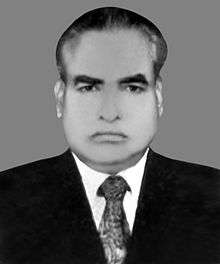Mohammad Mafzalur Rahman
| Colonel Dr. M. M. Rahman | |
|---|---|
 Dr. Colonel M. M. Rahman | |
| Born |
Mohammad Mafzalur Rahman April 1, 1920 Harbang, Chakaria, Cox's Bazar, British India |
| Died | June 14, 1994 (aged 74) |
| Cause of death | Myocardial Infraction due to old age |
| Resting place | Harbang, Chakaria, Cox's Bazar |
| Residence | Kala Shikdar Para, Harbang, Chakaria, Cox's Bazar, Bangladesh |
| Nationality | British Indian, Pakistani, Bangladeshi |
| Education | Mitford College, Dhaka |
| Occupation | Physician, soldier |
| Employer | Bangladesh Army, Pakistan Army, British Expeditionary Force (World War II) |
| Known for | His contribution in development of medical studies and Rural Health Service in Bangladesh |
| Parent(s) | Golam Quader Shikdar, a village leader and Feroza Begum |
| Relatives | Captain Advocate Fazlul Karim (Elder Brother), Flying Officer Waleed Ehsanul Karim Shaheed (Nephew) |
Mohammad Mafzalur Rahman (Bengali: মোহাম্মদ মফজলুর রহমান) (April 1, 1920 – June 14, 1994) was a Bangladeshi physician and soldier. He was the first C.O. of Chittagong CMH.
Early life
M. M. Rahman was born in the village of Harbang of Chakaria Upazila in the district of Cox's Bazar on 1 April 1920. He passed his Matriculation with science from Cox's Bazar and M.B. from Midford Medical School in 1940.
Career
He worked in Kolkata as a general physician and got his Royal Emergency Commission in The Indian Army Medical Corp (IAMC) as a Lieutenant on 23 May 1943 and send to Indian Military Academy in Dehradun. After a successful training he joined IAMC on 14 Sep 1943. He was posted in Akiyab and Rangoon where he had his experience on the 2nd World War. Although he was a doctor, he had fought in the Burma Front during the 2nd World War. As a Major he was the first Indian Officer to be posted as C.O. of Chittagong CMH before the independence of Pakistan. Later he served in the Pakistan Army and completed his M.B.B.S from Punjab Medical College in 1957.
He was one of the key person to help Bangabandhu Sheikh Mujibur Rahman to organize a meeting at Agartala which later became famous as Agartala Conspiracy Case. As a result, he was transferred to West Pakistan. He got arrested in 1971 during the War of Liberation of Bangladesh and saved three times by his colleagues who loved him as he was an honest and outspoken person.
After returning from Pakistan he was appointed as the Superintendent of Dhaka Medical College where he became successful in returning college into discipline. During the Sepoy Mutiny of November 1975, he was the first doctor to attend the victims of the outrage in Dhaka Medical College Hospital even after being posted there as an administrative person. The rebel soldiers kept threatening him, but instead he brought his long unused Colonels Uniform and treated the injured military personnel brought there with other doctors, who were encouraged to see him working with them side by side.
Later he was appointed as Director Medical Services (D.M.S.) in the Bangladesh Army and successfully developed the newly formed Bangladesh army Medical Corps to a professional Unit.
After retirement
After his retirement, he was moved to his home village of Harbang and devoted his life in helping the poor. He was building a hospital there with what money he had, but couldn't finish it. He died on 11 June 1994 from Myocardial Infraction. He even treated some patients even after his death.
References
- Smaraniyo Baraniyo (Chakaria-Pekua) by Anowar Hossain, Printed Sept 2003, Page 94